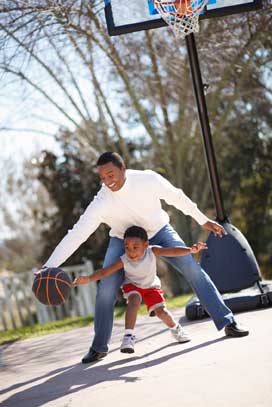
By NATALIE DIGATE MUTH, M.D., M.P.H., R.D.
People cite many reasons for not being physically active—not enough time, not enough fun, not enough energy…the list goes on. But it turns out that one of the most telling factors is whether or not a person has kids.
It’s no secret that parenting young children is time-consuming and stressful, a fact confirmed by studies like the one conducted by researchers from the University of Minnesota comparing the health habits of young adults with and without children. This study assessed the eating and physical-activity behaviors of 1,500 socioeconomically and ethnically diverse young adults. Results showed that moms drank more sugary drinks and ate 400 more calories per day, more saturated fat and fewer dark green vegetables (the healthiest kind of vegetable), and exercised less than the non-moms. With all that bad news, it’s not surprising that the moms also weighed more than the non-moms. Dads had lower physical-activity levels, but no major nutrition changes and no difference in BMI than the non-dads (Berge et al., 2011). From this study, and others like it, it is clear that parenthood can take quite a toll on the health habits of parents. In fact, a review of 25 studies on the topic of parenting and physical activity found that parents with young kids are far less active than non-parents (Bellows-Riecken and Rhodes, 2008).
Parents as Role Models for Healthy Behaviors
The activities that parents engage in every day just to care for and play with their children count, but finding the time to commit to an exercise program helps a person feel better and achieve or maintain a healthy weight. Furthermore, in the current environment of rampant physical inactivity, ready access to highly processed and calorie-dense foods, and epidemic rates of childhood and adult obesity, the best thing parents can do to help set their children on the path to maximal health and well-being—which includes eating healthfully and engaging in physical activity on a regular basis—is to model healthy behaviors. In fact, time and again, research has shown that the most effective strategy for preventing and reducing childhood obesity is to focus exclusively on the parent (Golan, Kaufman and Shahar, 2006; Golan and Crow, 2004; Golan et al., 1998). One study found that specifically training parents in healthy lifestyle habits led to a 10 percent weight loss in moderately obese five- to nine-year-old children—and this loss was maintained for two years (Magarey et al., 2011). Another found that a parent-centered nutritional program that focused on parental goal-setting, role modeling and positive reinforcement was essential for sustainable weight improvements in obese kids (Collins et al., 2011). In short, one promising way to help both adults and children to adopt healthier habits and a more active lifestyle is to convince the parent, as primary caretaker and role model, to make physical activity a family priority.
Easy to Say, Harder to Do

Parents commonly cite fatigue and lack of time, childcare and social support as barriers to getting the recommended 60 minutes of physical activity each day. So what can be done to help parents reverse the trend toward decreased activity that so often follows the joyous arrival of a new family member? Here are a few tips you can offer parents who claim that there’s just no way to balance the demands of parenthood and carve out an hour a day to work out.
- Take the kids along for the ride. “The best way for me to exercise is to take both kids out in the jogging stroller. Once or twice a week I meet some other moms at the walking trail. Pushing 60-plus pounds of kids and stroller up and down hills for an hour is a pretty good workout!” recommends Danielle Rattray, mother to Owen (4) and Hannah (1).
- Ask for help. Lean on a spouse or partner to watch the kids for a few minutes and go for a quick workout. Working parents often want to spend every non-working moment with the kids, but sometimes carving out a few minutes of personal time can make all the difference. “It’s hard not to feel guilty taking time to exercise by yourself when I already feel like I don't get to spend enough time with [two-year-old] Xavier,” says Amber Curran. “But it keeps me happier and less crazy, so I figure that benefits him as well.” After all, she says, “No one wants a nutty mother!”
- Make a game of it. Barb Ruvarac, mother of school-aged children, Samantha and Zach, pushed herself to meet a predefined number of steps each day. If that means staying up late to get the steps in, so be it. “When Samantha went to bed I would finish my steps on the treadmill to reach 10,000 steps. Some days I’d only have to walk for 30 minutes, some days it would take longer. Then, I graduated from walking to running. Then my husband signed us up for the Shamrock Shuffle in 2010—first running event ever! And by May of 2010, I’d lost 20 pounds and two dress sizes!” Barb is now an avid half-marathoner and highly active role model to her highly active children.
- Prioritize. In describing her commitment to exercise despite working full-time and raising a nine-month-old, Beth Read uses an analogy that we all can relate to: “Like they tell you in the airplane...put on your oxygen mask first before assisting others.” Whether that means waking up before the children or staying up a little bit later, getting a few minutes of physical activity sets the stage for a more productive day and well-balanced person.
- Set goals. Tackling the most challenging health struggles becomes a little bit easier with goal-setting. Try this exercise: Write down three goals—a nutrition goal, a fitness goal and a behavioral goal. Operationalize this goal as much as possible by trying to make sure that the goal is SMART. Specific: What is it exactly that you hope to achieve? Measurable: How will you know if you got there? Attainable: Make sure it is something realistic that you are going to be able to achieve with some moderate amount of effort. Relevant: Choose goals that really are meaningful to you and that will help you feel like you’ve really accomplished something. And Timely: Set a date for when you hope to achieve your goal that is far enough in the future to give you time to meet it, but not so far that you will lose interest before reaching it.
- Commit to setting an example. It’s simple: Kids pay attention to what their parents are doing. Despite the many barriers to physical activity, taking the time—even if it’s just a few minutes per day—to engage in physical activity sets a powerful example for children. The repeated opportunities to see how you eat and play make it easy for kids to remember the experiences. And kids are motivated to copy their parents’ actions.
While there are a million reasons not to be physically active, parents who make getting regular exercise a priority are not only more likely to be fit and healthy themselves, they are also more likely to raise fit and healthy children. To fight the epidemic of obesity in the United States—especially reversing childhood obesity—parents have to be the first ones to stand up, lace our shoes and lead the charge.
References
Bellows-Riecken, K.H. and Rhodes, R.E. (2008). A birth of inactivity? A review of physical activity and parenthood. Preventive Medicine, 46, 2, 99–110.
Berge, J.M. et al. (2011). Are parents of young children practicing healthy nutrition and physical activity behaviors? Pediatrics, 127, 5, 881–887.
Collins, C.E. et al. (2011). Parent diet modification, child activity, or both in obese children: An RCT. Pediatrics, 127, 4, 619–627.
Golan, M., Kaufman, V. and Shahar, D.R. (2006). Childhood obesity treatment: Targeting parents exclusively v. parents and children. British Journal of Nutrition, 95, 5, 1008–1015.
Golan, M. and Crow, S. (2004). Targeting parents exclusively in the treatment of childhood obesity: Long-term results. Obesity Research, 12, 2, 357–361.
Golan, M. et al. (1998). Parents as the exclusive agents of change in the treatment of childhood obesity. American Journal of Clinical Nutrition, 67, 6, 1130–1135.
Magarey, A.M. et al. (2011). A parent-led family-focused treatment program for overweight children aged 5 to 9 years: The PEACH RCT. Pediatrics, 127, 2, 214–222.

Natalie Digate Muth, M.D., M.P.H., R.D., is a pediatrics resident at UCLA Medical Center, a registered dietitian and a spokesperson for the American Council on Exercise (ACE). She holds fitness certifications from ACE, the American College of Sports Medicine and the National Strength and Conditioning Association. She’s also mom to two young children, Tommy (3) and Mariella (11 months).